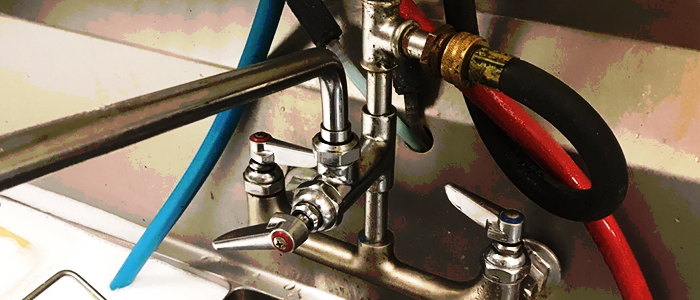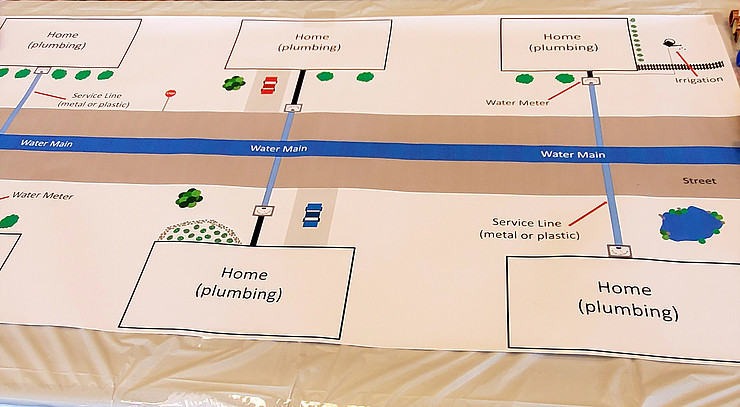Key Parts of Your Home's Plumbing System
Key Parts of Your Home's Plumbing System
Blog Article
This great article down the page involving Exploring Your Homes Plumbing Anatomy is extremely enjoyable. You should take a peek.

Comprehending just how your home's plumbing system functions is crucial for each house owner. From providing clean water for alcohol consumption, food preparation, and bathing to safely removing wastewater, a well-maintained pipes system is important for your family's wellness and comfort. In this comprehensive overview, we'll explore the complex network that composes your home's plumbing and offer pointers on maintenance, upgrades, and taking care of typical concerns.
Introduction
Your home's plumbing system is greater than simply a network of pipes; it's an intricate system that ensures you have access to tidy water and reliable wastewater removal. Understanding its parts and how they interact can assist you prevent expensive repairs and make sure everything runs efficiently.
Fundamental Components of a Plumbing System
Pipelines and Tubes
At the heart of your pipes system are the pipes and tubing that bring water throughout your home. These can be made from various materials such as copper, PVC, or PEX, each with its benefits in terms of resilience and cost-effectiveness.
Fixtures: Sinks, Toilets, Showers, etc.
Components like sinks, toilets, showers, and bath tubs are where water is made use of in your house. Understanding just how these components attach to the plumbing system aids in detecting problems and preparing upgrades.
Shutoffs and Shut-off Points
Shutoffs control the circulation of water in your pipes system. Shut-off valves are important during emergencies or when you need to make fixings, permitting you to isolate parts of the system without disrupting water circulation to the whole home.
Supply Of Water System
Main Water Line
The major water line attaches your home to the municipal water system or a private well. It's where water enters your home and is distributed to numerous fixtures.
Water Meter and Stress Regulator
The water meter steps your water use, while a pressure regulator guarantees that water streams at a safe pressure throughout your home's pipes system, stopping damage to pipes and components.
Cold Water vs. Warm water Lines
Recognizing the difference between cold water lines, which provide water directly from the primary, and warm water lines, which bring heated water from the water heater, aids in troubleshooting and planning for upgrades.
Water drainage System
Drain Pipes Water Lines and Traps
Drain pipelines carry wastewater away from sinks, showers, and toilets to the sewage system or septic system. Traps protect against drain gases from entering your home and also catch particles that might trigger blockages.
Air flow Pipes
Ventilation pipes allow air right into the drain system, avoiding suction that can slow down drain and cause catches to vacant. Appropriate ventilation is necessary for maintaining the integrity of your plumbing system.
Importance of Proper Drainage
Making sure appropriate drain stops backups and water damage. Routinely cleaning up drains pipes and keeping traps can stop costly repair services and extend the life of your plumbing system.
Water Heating Unit
Types of Water Heaters
Water heaters can be tankless or standard tank-style. Tankless heating units warm water as needed, while tanks store heated water for prompt use.
Updating Your Pipes System
Reasons for Upgrading
Updating to water-efficient fixtures or replacing old pipelines can enhance water top quality, decrease water costs, and enhance the worth of your home.
Modern Pipes Technologies and Their Advantages
Check out modern technologies like smart leak detectors, water-saving commodes, and energy-efficient hot water heater that can conserve cash and decrease environmental influence.
Cost Factors To Consider and ROI
Determine the in advance prices versus long-term financial savings when thinking about plumbing upgrades. Lots of upgrades pay for themselves through lowered energy costs and fewer fixings.
Exactly How Water Heaters Attach to the Pipes System
Comprehending how water heaters link to both the cold water supply and warm water distribution lines aids in diagnosing problems like inadequate warm water or leakages.
Upkeep Tips for Water Heaters
Regularly flushing your water heater to remove sediment, inspecting the temperature level setups, and inspecting for leakages can expand its life-span and improve energy effectiveness.
Typical Pipes Concerns
Leakages and Their Reasons
Leaks can happen because of aging pipes, loose installations, or high water pressure. Resolving leaks without delay protects against water damages and mold and mildew development.
Blockages and Obstructions
Blockages in drains and toilets are typically triggered by flushing non-flushable products or a build-up of grease and hair. Utilizing drainpipe displays and bearing in mind what decreases your drains pipes can avoid blockages.
Signs of Plumbing Troubles to Watch For
Low tide pressure, sluggish drains pipes, foul odors, or abnormally high water expenses are indications of possible plumbing troubles that ought to be resolved without delay.
Pipes Maintenance Tips
Normal Evaluations and Checks
Set up annual pipes assessments to capture concerns early. Seek indications of leakages, deterioration, or mineral build-up in taps and showerheads.
DIY Maintenance Tasks
Basic tasks like cleaning faucet aerators, checking for toilet leaks using color tablets, or insulating subjected pipes in cool environments can protect against significant pipes issues.
When to Call a Specialist Plumber
Know when a pipes problem needs expert proficiency. Attempting complex repair work without appropriate understanding can result in even more damage and greater repair prices.
Tips for Reducing Water Use
Straightforward practices like fixing leakages quickly, taking shorter showers, and running full loads of laundry and meals can save water and reduced your energy expenses.
Eco-Friendly Pipes Options
Consider lasting plumbing materials like bamboo for floor covering, which is durable and eco-friendly, or recycled glass for countertops.
Emergency Readiness
Actions to Take Throughout a Pipes Emergency situation
Know where your shut-off valves lie and just how to shut off the water in case of a ruptured pipeline or significant leakage.
Value of Having Emergency Get In Touches With Helpful
Keep get in touch with information for neighborhood plumbings or emergency situation solutions conveniently offered for quick action during a plumbing crisis.
Ecological Effect and Conservation
Water-Saving Fixtures and Home Appliances
Installing low-flow faucets, showerheads, and commodes can dramatically minimize water usage without compromising performance.
DIY Emergency Fixes (When Relevant).
Short-term solutions like making use of duct tape to spot a leaking pipe or positioning a pail under a leaking tap can reduce damage till a professional plumbing gets here.
Conclusion.
Comprehending the anatomy of your home's plumbing system empowers you to keep it efficiently, conserving time and money on repair work. By complying with routine upkeep regimens and remaining informed about modern-day pipes modern technologies, you can ensure your pipes system runs efficiently for years to find.
HOW YOUR PLUMBING SYSTEM WORKS
Which Pipes Do What?
Blue lines = fresh water supply entering the building Red lines = hot water supply entering the building Grey lines = pipes carrying waste away from the building and venting pipes carrying gases away from the building (through the roof) YOUR MAIN PLUMBING SYSTEMS
There are two main plumbing systems that support your home s basic plumbing needs one that brings clean water into your home, and one that sends dirty water away from your home. Connected to the toilet, bath, shower, and other faucets in your home, these two systems keep your water flowing in the right directions.
ACCESSING FRESH WATER
Fresh and clean water is brought into your home through the main water supply line . Filtered through one pipe, this water is pressured to flow into the various fixtures in your home at any given time.
This water can be sourced from a well located on your property, a pond or river (mostly cottages), or, as in most cases, from the city s municipal water treatment centre. However, it is important to note that water that is untreated, such as the water siphoned from ponds or rivers, may not be safe to drink. Personal water supplies always need to be treated for hardness and contaminants before consumed.
MUNICIPAL WATER SUPPLIES
Improve taste and odour Remove sediment Eliminate hardness Reduce chlorine COLD WATER SUPPLY VS. HOT WATER SUPPLY
Cold water flows into your home or building through the service line, which then distributes hot or cold water to your fixtures. This line is most commonly run through a central column that runs floor to floor. Hot water runs in short and straight pipes as the longer the pipeline, the more heat that will be lost in the transfer. Having shorter pipes also allows residents to access hot water more quickly.
WASTE WATER SYSTEM
Your wastewater system is divided into two parts pipes that send wastewater away from your home and venting pipes that send sewer gas away from your home. Sewage water travels through pipes that flush the water and waste towards local sewers that are operated and managed by your city or town. Most sewer systems rely on gravity to move the wastewater to where it needs to go.
The further away from your toilet or sink, the larger wastewater pipes become. This allows for waste to be disposed of from various parts of your home or business at once without pipe blockages. The angle and flow of these pipes are also essential for keeping your waste pipes clear of build up.
https://harrisplumbing.ca/how-your-home-plumbing-system-works/

I hope you liked our excerpt about Anatomy of a House: Understanding the Components. Thanks so much for taking a few minutes to browse our article post. You should set aside a second to distribute this post if you liked it. Kudos for being here. Don't hesitate to come by our website back soon.
Schedule Service Pickup Report this page